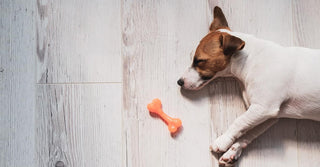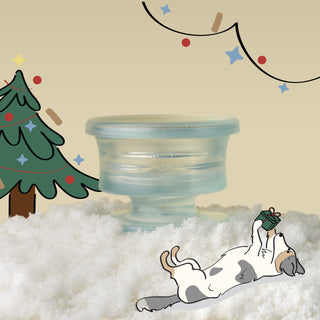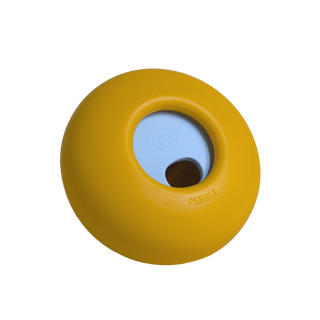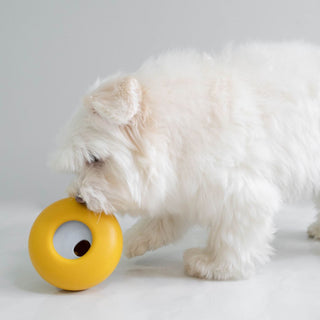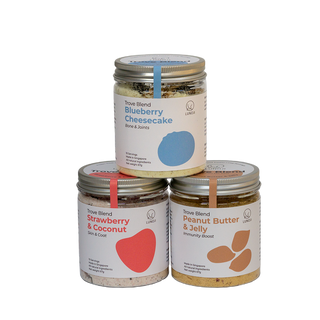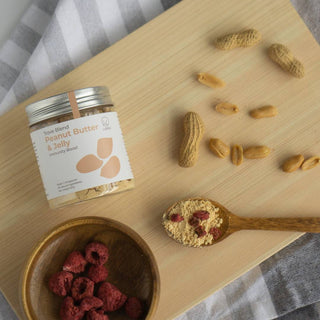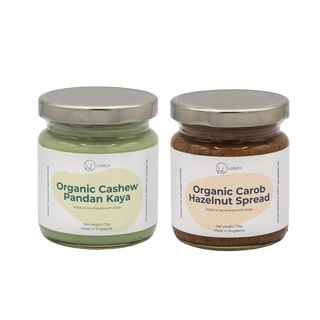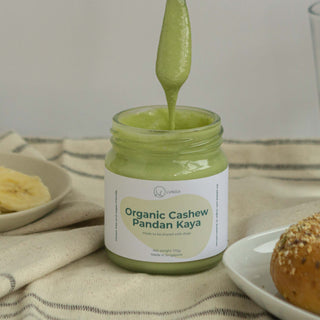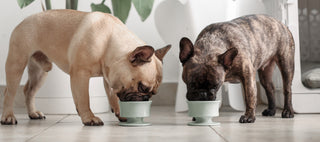In the winter of 2018, my fiancée and I embarked on a journey that put us through a roller-coaster love-hate relationship with dog chews. Along the way we explored a variety of chews. We also stumbled upon lesser-known benefits of chewing - we now know they make a good training aid, a source of nutrition, and it is a perfectly natural way for dogs to relieve anxiety and release pent up energy, in addition to bolstering dental health. We started to ask ourselves - is there a best chew for our dogs and how should we go about giving them to our dog?

Dog chews - a love-hate relationship?
A stressful pet dental surgery
It all started when we had to put our beloved domestic short-haired cat Luna through a standard tooth extraction due to resorption (a common problem for cats, and nothing can be done to avoid it). We were shocked to find that the procedure for both cats and dogs required general anaesthesia! It's obvious when you think about it - there's no way they would stay still otherwise! The surgery gave us a lot of worry due to the risks involved, as well as a hefty £900 bill (even premium insurance didn’t matter as dental procedures are not covered). Thankfully things went smoothly in the end, and Luna has since made a full recovery.
They start from pearly whites
Soon after, we adopted our big goofball of a greyhound in February of 2019 from a rehoming kennel. He had just retired from his racing career at the grand age of 3. Because of how he was blessed with an early greying face, we named him 'Oji' (it means 'an older gentleman' in Japanese). From day one we were determined to keep our greyhound’s pearly white set of teeth. He had a clean just before he joined our family - thank you for the amazing work you do Dunrunnin Rehoming Kennels) and we didn’t want him to have to go through what Luna did.

Oji our retired racer greyhound, day 4 with us, with perfect teeth
We brushed our dog’s teeth regularly; it was tough to begin with but we kept it going. He also had one of those self-brushing rubber toys with a reservoir filled with doggy toothpaste every single night. In our search for the chew that worked best for us, we tried out all sorts - dental sticks, antlers, natural rawhide, tendon, jerkies, ears, raw bones, chew toys, and the list goes on. He even had seaweed powder added to every meal which purportedly helps remove plaque.

A representation of what we tried feeding Oji (illustrative only and not to proportion)
The issues with dog chews

Many ‘dental chews' can be devoured within seconds by our pooches. Should they still be called chews?
The dog chews presented an interesting dilemma. Oji would quickly get bored with inedible chews like antlers and synthetic chew toys. We also learned the ‘hard’ way about how hard antlers are and took his away after it chipped one of his upper teeth. Edible chews and bones on the other hand, were tasty. And my dog loved them. But because he did, he would devour them in a matter of seconds.
I can’t speak for all brands, but the biggest culprits for us were dental sticks given their softer texture. They were our initial top choice given their lower price point and wide claims on their pristine packaging, but watching him break off and swallow big chunks of the dental sticks were heart-stopping affairs. Our expectations were so low that we would be celebrating if these dental stick chews lasted more than a minute. Fortunately, any swallowed chunks would often be expelled through coughs or vomits - and I’d take those anytime over choking or intestinal blockages.
Overtime however, my fiancée, who was a dentist, quickly caught onto the ingredient list of one of the dental chews I was buying, and she found that most dental sticks contained primarily carbohydrates and starch that break down into sugars in the mouth, expediting plaque formation. We concluded that they weren’t benefiting him much, but instead contributed more towards his waist-line.

Providing a high value safe chew can help your dog's separation anxiety.
We knew we had to change something. I started doing more research on brushing and chewing. I paid attention to the teeth of dogs at the park, and chatted up owners and vets about doggy dental care routine. I found that hardly anyone kept up with brushing their dogs teeth. The adult dogs that had pearly whites were often provided with lots of long-lasting edible and natural chews such as beef trachea, duck neck, or raw meaty recreational bones.
This made sense. Chewing on these tough and uneven surfaces mechanically scrape tartar off the teeth, and at the same time helps our dogs produce more cavity-fighting saliva that also works to decrease the germs in the mouth that cause bad breath.

100% raw feeding can yield great results for teeth, but requires careful logistics and planning to meet nutritional needs and maintain hygiene for both pets and their human counterparts
Single ingredient natural dog chews - the pros and cons
We started to provide Oji with only these single ingredient natural chews.
On the plus side, they last longer and definitely help with maintaining his doggy dental health. We also found that giving our dog these types of chews right before we left the room or home helped a lot with his separation anxiety. He would be so focused on the chew that he wouldn’t even realise we’d left. These natural chews were also great for cold rainy days, because it could help drain him of energy while we cut down on the walking time; and we'd feel less guilty (even though most of the time our greyhound would be pulling to turn back the moment he realises it was raining!).
On the other hand, these natural chews can be pricey, and they also often left a lot of mess (we lived in a one-bedroom flat in central London and aren’t blessed with a private garden). We were constantly stepping on chew crumbs or cleaning stains off of our carpets, sofa covers and his bed, so we started to train our dog to eat in a fixed spot with a towel underneath. It was a make-shift solution that would sometimes work, but more often than not the chews would end up rolling off of the towel due to his lack of dexterity. He would also get chew slime on his paws which then quickly spread germs around the flat if you’re not there to stop it - you know how it is.

Oji, our greyhound, chewing on a bone on a towel indoors
To avoid the mess indoors we tried giving him a raw bone in a quiet area outside despite the biting winter cold, but our early celebratory smiles quickly turned to dismay as we watched Oji’s slimy bone pick up grass, mud, and other ‘goodies’ off the ground straight into his mouth. Of course, we had also forgotten that despite its greenish-brown off-putting appearance, his bone smelled wonderful to other local dogs and they had come to investigate. He then understandably tried his best to keep it all to himself by attempting to swallow the bone. Needless to say that was our first and last time doing that.

Chewing outside isn't always pretty for our furry friends.
Shortly after, we heard the unfortunate news that a dog who lived in our neighbourhood - a dog whom we knew - had just passed away from choking on a chew.
We had found the right chews for our dog, but it had become an anxiety inducing chore to provide them. Discouraged, we gradually cut down on providing dog chews.
Is there nothing that can make chewing a better experience?
Sure enough, by the end of 2020, plaque had built up to the point where Oji’s breath started to become noticeably bad, and his gum-line had a thick yellow gunk that couldn’t come off despite all that regular tooth-brushing.

Plaque and calculus started accumulating on Oji's teeth over time, although brushing has helped to slow it down.
I really didn't want to take Oji to have to go through general anaesthesia for a dental clean. Some places offered cleans without them, but of course they came with other risks and most importantly the clean wouldn't reach under the gum-line properly. Dog chews offered so many uses and benefits including helping to improve oral health - surely there had to be a way to make chewing a better experience for us all?
At the turn of the year, I started researching for products that could help. I quickly found a category of products which are essentially 'dog chew holders'. The products I found were designed to reduce the risk of choking for a single type of chew, and the most common were bully sticks (bull penis). You also had to measure and make sure that your bully sticks would fit, or risk the product not being compatible. Of course you could buy the sticks from these companies which would guarantee a fit. In fact, for some of these products you can only use chews that have an appropriately sized hole drilled through beforehand. So they lock you in by selling you - you guessed it - pre-drilled dog chews.

Bully sticks (or pizzle sticks) are in fact bull penises. The last couple of inches of them are a common choking or blockage hazard.
Don’t get me wrong, these products were great. Most of them effectively reduced the risk of choking, and I am a huge fan of anyone making this world a safer place for dogs. I just thought we could do more on top of that and come up with a more innovative dog chew holder:
-
I didn’t want to be limited to giving only one type of chew, certainly not from just one supplier. Expert consensus on chews can change, and many of us folks can only try to make the best decision for our pets based on that. I also like to think my dog enjoys a wide variety of tastes and smells, and not to mention the diversity of nutrients that could be derived from different chews.
-
I wanted a chew holder that would make it safer for dogs to enjoy their chews, and effectively reduce the risk of choking or intestinal blockages. The exposed areas also needed to be safe for dogs to chew on.
-
I hated to deal with the crumbly slimy mess or stained carpets and was sure many would agree. I thought that there must be a way to prevent the chews, raw bones, their crumbs, and doggy drool from dirtying the ground, furniture, or doggy paws.
-
I wanted something that could help make these pricey chews last longer. The longer they last, the more my dog would stay happily engaged, and the more work it does for his dental health.
A haven for chewing
With those ideas in mind, I pulled my sleeves up and got to work in the evenings. I built prototype after prototype. I tested them all with dogs of different breeds and chews of different shapes and sizes. Dogs of friends and family came to be our unforgiving testers, and I am ever so grateful to all of them (don't worry, they were all compensated handsomely with healthy dog chews).
Months in and on our 12th prototype, we finally had a prototype that proved that it was possible to make such a dog chew holder. Your dog’s favourite chew - longer lasting, safer, and mess-free. Wherever we placed the chew holder it became a haven or sanctuary for our dogs to enjoy their chews - a den of sorts.
We named it CHEWDEN.
CHEWDEN has now completed its development with a team of professional product designers and engineers in Singapore, having undergone more iterations of prototyping and rigorous testing.
 Luna + Oji, in the comfort of our home.
Luna + Oji, in the comfort of our home.

